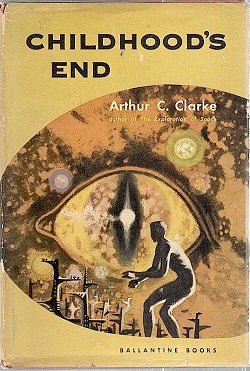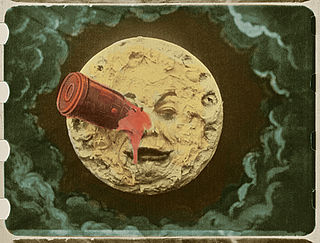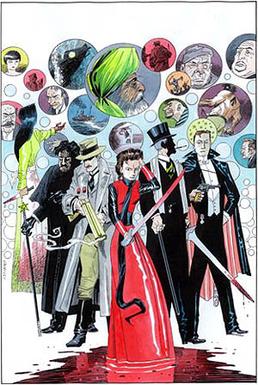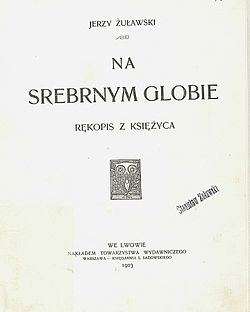
Childhood's End is a 1953 science fiction novel by the British author Arthur C. Clarke. The story follows the peaceful alien invasion of Earth by the mysterious Overlords, whose arrival begins decades of apparent utopia under indirect alien rule, at the cost of human identity and culture.
Science fiction comedy or comic science fiction is a subgenre of science fiction or science fantasy that exploits the science fiction genre's conventions for comedic effect. Comic science fiction often mocks or satirizes standard science fiction conventions, concepts and tropes – such as alien invasion of Earth, interstellar travel, or futuristic technology. It can also satirize and criticize present-day society.

From the Earth to the Moon: A Direct Route in 97 Hours, 20 Minutes is an 1865 novel by Jules Verne. It tells the story of the Baltimore Gun Club, a post-American Civil War society of weapons enthusiasts, and their attempts to build an enormous Columbiad space gun and launch three people — the Gun Club's president, his Philadelphian armor-making rival, and a French poet — in a projectile with the goal of a Moon landing. Five years later, Verne wrote a sequel called Around the Moon.

Gemini 11 was the ninth crewed spaceflight mission of NASA's Project Gemini, which flew from September 12 to 15, 1966. It was the 17th crewed American flight and the 25th spaceflight to that time. Astronauts Charles "Pete" Conrad Jr. and Richard F. Gordon Jr. performed the first direct-ascent rendezvous with an Agena Target Vehicle, docking with it 1 hour 34 minutes after launch; used the Agena rocket engine to achieve a record high-apogee Earth orbit; and created a small amount of artificial gravity by spinning the two spacecraft connected by a tether. Gordon also performed two extra-vehicular activities for a total of 2 hours 41 minutes.

A Trip to the Moon is a 1902 French science-fiction adventure trick film directed by Georges Méliès. Inspired by Jules Verne's 1865 novel From the Earth to the Moon and its 1870 sequel Around the Moon, the film follows a group of astronomers who travel to the moon in a cannon-propelled capsule, explore the moon's surface, escape from an underground group of Selenites, and return to earth with a captive Selenite. Méliès leads an ensemble cast of French theatrical performers as the main character Professor Barbenfouillis.

First Men in the Moon is a 1964 British science fiction film, produced by Charles H. Schneer, directed by Nathan Juran, and starring Edward Judd, Martha Hyer and Lionel Jeffries. The film, distributed by Columbia Pictures, is an adaptation by screenwriter Nigel Kneale of H. G. Wells' 1901 novel The First Men in the Moon.

The Moon has appeared in fiction as a setting since at least classical antiquity. Throughout most of literary history, a significant portion of works depicting lunar voyages has been satirical in nature. From the late 1800s onwards, science fiction has successively focused largely on the themes of life on the Moon, first Moon landings, and lunar colonization.

Voyage: Inspired by Jules Verne is a point-and-click adventure game with pre-rendered graphics, developed by Kheops Studio and published by The Adventure Company for the PC in 2005. The game's story focuses on a French adventurer's journey to the Moon in the 19th century, and the ancient lunar civilization he subsequently finds.

The First Men in the Moon by the English author H. G. Wells is a scientific romance, originally serialised in The Strand Magazine and The Cosmopolitan from November 1900 to June 1901 and published in hardcover in 1901. Wells called it one of his "fantastic stories". The novel recounts a journey to the Moon by the two protagonists: a businessman narrator, Mr. Bedford; and an eccentric scientist, Mr. Cavor. Bedford and Cavor discover that the Moon is inhabited by a sophisticated extraterrestrial civilisation of insect-like creatures they call "Selenites". The inspiration seems to come from the famous 1865 book by Jules Verne, From the Earth to the Moon, and the opera by Jacques Offenbach from 1875. Verne's novel also uses the word "Selenites" to describe inhabitants of the Moon.

The League of Extraordinary Gentlemen, Volume III: Century is the third volume of The League of Extraordinary Gentlemen, written by Alan Moore and illustrated by Kevin O'Neill. Co-published by Top Shelf Productions and Knockabout Comics in the US and UK respectively, Century was published in three distinct 72-page squarebound comics.
Robert Godwin is a British author who has written about rock music and spaceflight. Early in his career he was a rock music impresario who managed a venue in Burlington, Ontario, and founded Griffin Music.

The Lotus Caves is a juvenile science fiction novel by John Christopher, first published in 1969.
Hogben is a surname. Notable people with the surname include:

The First Men in the Moon, also promoted as H. G. Wells' The First Men in the Moon, is a 2010 television drama written by Mark Gatiss, directed by Damon Thomas, that stars Gatiss as Cavor and Rory Kinnear as Bedford, with Alex Riddell, Peter Forbes, Katherine Jakeways, Lee Ingleby and Julia Deakin. The First Men on the Moon was first broadcast on 19 October 2010 on BBC Four. It is an adaptation of H. G. Wells' 1901 science fiction novel of the same name. This is the third collaboration between Thomas and Gatiss, and the first film to be produced by their production company Can Do Productions.

The Man in the Moone is a book by the English divine and Church of England bishop Francis Godwin (1562–1633), describing a "voyage of utopian discovery". Long considered to be one of his early works, it is now generally thought to have been written in the late 1620s. It was first published posthumously in 1638 under the pseudonym of Domingo Gonsales. The work is notable for its role in what was called the "new astronomy", the branch of astronomy influenced especially by Nicolaus Copernicus. Although Copernicus is the only astronomer mentioned by name, the book also draws on the theories of Johannes Kepler and William Gilbert. Godwin's astronomical theories were greatly influenced by Galileo Galilei's Sidereus Nuncius (1610), but unlike Galileo, Godwin proposes that the dark spots on the Moon are seas, one of many parallels with Kepler's Somnium sive opus posthumum de astronomia lunari of 1634.

12 to the Moon is a 1960 independently made American black-and-white science fiction film, produced and written by Fred Gebhardt, directed by David Bradley and starring Ken Clark, Michi Kobi, Tom Conway and Anna-Lisa. The film was distributed in the U.S. by Columbia Pictures as a double feature with either Battle in Outer Space or 13 Ghosts, depending on the local film market.

Trylogia Księżycowa is a trilogy of science fiction novels by the Polish writer Jerzy Żuławski, written between 1901 and 1911. It has been translated into Russian, Czech, German, English and Hungarian, and has been reprinted several times in Poland. They are his best-known works.

Five Against Venus, written by Philip Latham, is a science-fiction novel first published in the United States in 1952 by the John C. Winston Company. Philip Latham was the nom de plume of Robert S. Richardson, a professional astronomer who also provided technical assistance on movies such as Destination Moon and wrote scripts for the Captain Video television series.

Cavorite is a fictional material first depicted by H. G. Wells in The First Men in the Moon, a 1901 scientific romance. Developed by Cavor, a reclusive physicist, it has the ability to negate the force of gravity, enabling him and a businessman named Bedford to travel to the Moon using a spherical spacecraft propelled by Cavorite blinds. The material was later referenced in numerous works of science fiction media, and its theoretical implications have been discussed by critics.
















